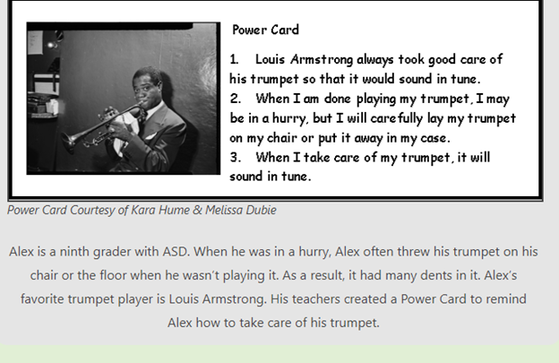 This month, I plan to continue to highlight the EBP of ‘social narratives’ (third and final installment for SNs). SNs are typcially associated with ‘social stories’ but it is broader as we will also discuss ‘power cards’ too. Part one outlined a huge list of goals that this strategy can help to address and these can help decide if this is an appropriate strategy to try. For this third part, we will look at more specific examples of social stories and power cards and more bits of related information. The research shows this is effective from the ages of 5-22 although if you wanted to try it with older or younger learners then I would do that. Much of the information in this article is from the related AFIRM online module (link below). Social Stories help learners with ASD understand the situation and other people’s perspective. Power Cards use a learner’s special interest to describe rules and behavioral expectations of a social situation. You can use this general rule of thumb when deciding which one you should choose to address a certain goal. In the last article, we discussed steps to consider when creating a SN. Here is a bit more information on Power Card creation in particular (still considering the general suggestions outlined previously). Power Cards typically involve a scenario that the learner may find challenging in some way (behaviorally, academically, socially, etc.). Then, a list of expectations or rules are clearly laid out to follow. These can be created on index cards for example and can be kept (laminated for durability if needed) for regular reference. They are portable so are easy to take to different locations if needed or applicable too. The learners’ special interests can be incorporated into the power card too. You can write them specifically for the situation and learner to help personalize it and address the specific goal (but you can purchase premade ones as well). See examples provided. Whether you choose a social story or power card, find a distraction free space to introduce and use it. The learner will be able to focus on it and the chance of understanding will go up. Explain to the learner what the social narrative is about and the important aspects to keep in mind while reading. After the learner has read the social narrative (or been read to depending on the age/reading ability), ask the learner three to five comprehension questions about the narrative. The learner’s answers will help you determine if the learner understands the concepts in the narrative. Consider using role plays to provide the learner with an opportunity to practice the target skill or behavior. SNs are also proven to work better if read/shared/reviewed directly before the target behavior/situation is about to happen. For example, if the learner is about to go for a job interview, reviewing the SN right before the interview is the best bet for success. Social stories or power cards can be an effective tool when discussing more personal or sensitive topics (hygiene related, relationship related, etc.) as well. It can help to lay information out clearly and plainly in a way that can help the learner to understand. Having text and/or pictures can be helpful as well in terms of providing extra context and information depending on the learner’s ability to take in new information. It can also help to have a focal point to look at when discussing sensitive topics. If you want more information how to begin to use SNs, create them (or purchase), whether they be social stories or power cards, ask your child’s school/teacher, a speech pathologist, any autism specialist or do your own research as there is a lot of information about it. I have witnessed the power of this strategy work firsthand and firmly believe in the power of SNs. This tool can (and sometimes should be) used in conjunction with other strategies (such as visuals, prompting or using reinforcement for attention and/or success) if needed as well. Look for part one of the next evidence based practice for another ‘power tool’ for your proverbial ‘tool kit’ of what is proven to work. If you are interested in checking out the free online AFIRM modules, here is the link (will take you to the social narrative module in particular as I am highlighting this here). https://afirm.fpg.unc.edu/node/589
0 Comments
Leave a Reply. |
Filter Posts by Topic
All
AuthorCarmen has been published in a variety of online and print articles. Writing is a passion and she strives to grow and share her message. |
Photos from shixart1985 (CC BY 2.0), JLaw45, Goat Tree Designs, osseous, wuestenigel, shixart1985

 RSS Feed
RSS Feed